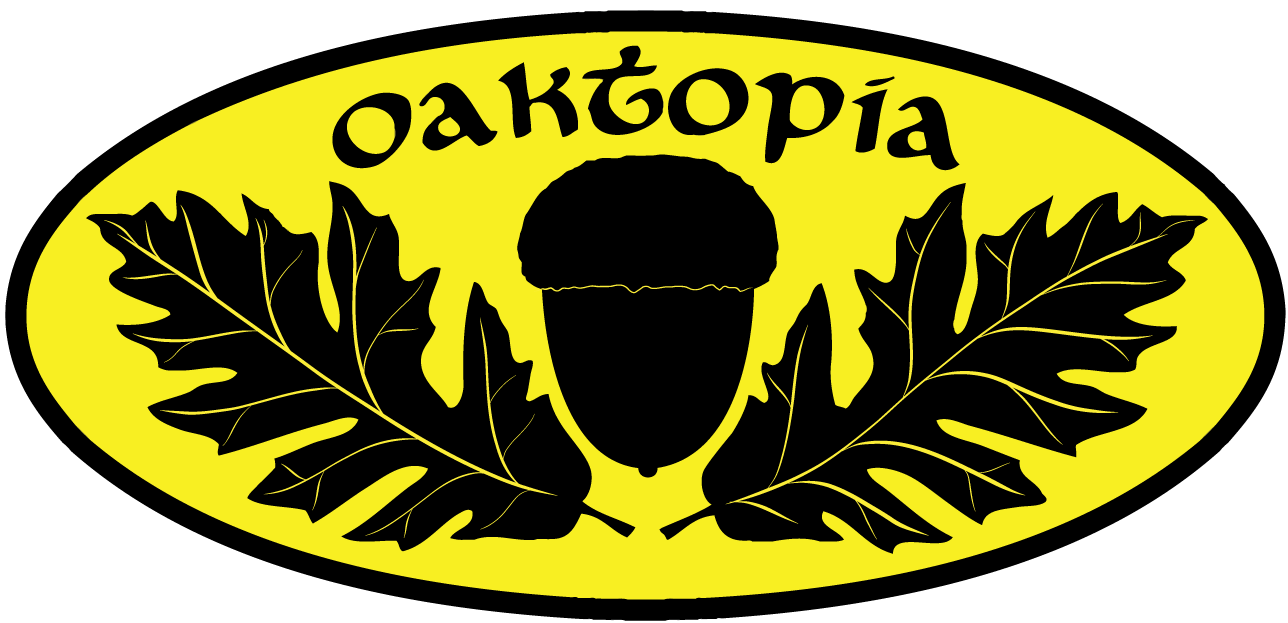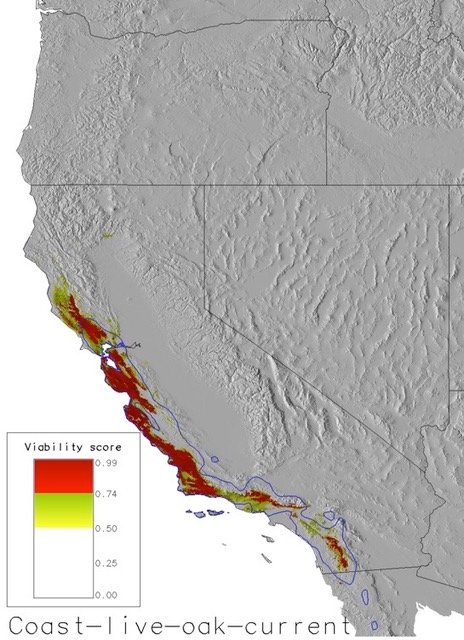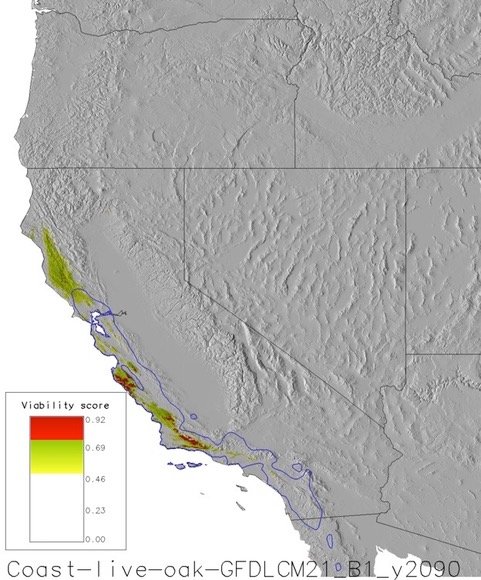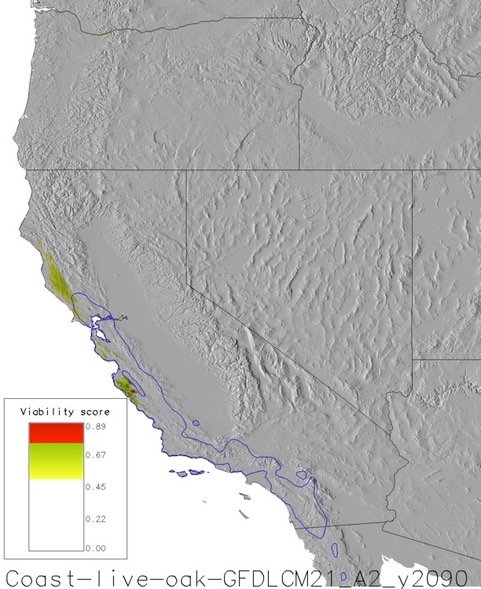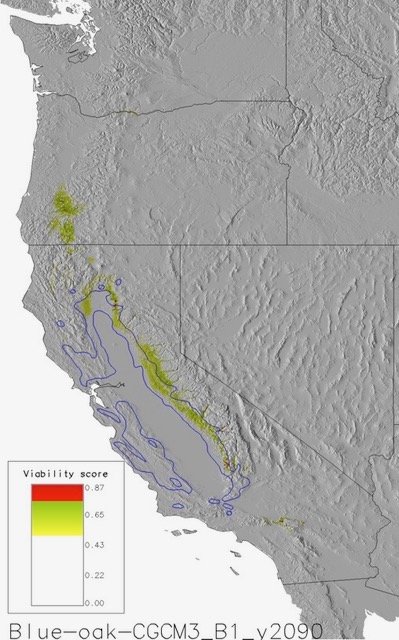
Climate Change Scenarios for Select California Native Oaks
Today, one of the urgent questions in horticulture is what planting strategies are best for the rapid climate change we are experiencing. One common proposal is to assert that local native plants are best adapted to current and future climate flux. But this assertion is proving out of step with modern climate science. Published scientific projections of future geographical range of California trees show movements from hundreds to the low thousands of miles, often right out of California.
All images displayed here can be found at this website:
http://charcoal.cnre.vt.edu/climate/species/
To assist in sharing this vital information more widely, we have collected here long term projections of the future range for key California native trees. We start with coast live oak (Quercus agrifolia), the most common of all native trees in the southern two-thirds of coastal California.
Coast live oak has a notably limited range of adaptation, and hugs the coast of California, rarely being found more than 50-100 miles from the coast. It is difficult for coast live oak to grow north of its current range, due to heavy rainfall where coast redwood (Sequoia sempervirens) dominates. Movement inland is limited by geography and inland weather conditions.
Coast live oak is boxed in by evolved adaptations to unique conditions. Conditions within the box are changing rapidly by ecological standards. Coast live oak is particularly vulnerable to climate change.
Coast Live Oak (Quercus agrifolia)
We start with the approximate current range of coast live oak (Quercus agrifolia) showing the match to current climate conditions. The current range is shown in blue outline, though it should be noted that the inland populations of putative coast live oak (Quercus agrifolia) shown are typically thoroughly hybridized with interior live oak (Quercus wislizenii), which may go a long way toward understanding the differences visible here.
One important question is, where will coast live oak be by the end of the century?
To answer this question, we now move through 6 different climate scenarios, intended as end of century projections for 2090. Please keep in mind that oak trees can live for hundreds of years, so trees planted today may still be relatively young when this milestone is reached.
As of this writing, these scenarios are 10 years old. There is general agreement that the pace of climate change has accelerated since then, and we could see these scenarios play out decades earlier if we continue on our high emission path to the future. There is major need to repeat and update this crucial research.
As for where coast live oak may be headed in the future, let's start by looking at a couple of the most optimistic scenarios.
Even the most optimistic scenarios suggest massive range contraction, and little or no range expansion. Things get awfully wet as one moves north in California, and coast live oak really needs dry root conditions for the hot time of the year.
Now let's look at the remainder of the scenarios. Remember the blue outline is current range. In these scenarios we are seeing a truly massive range contraction, with only a small range expansion.
The future is looking rather bleak for coast live oak, and there are clear signs of population level stress in coast live oak populations throughout their native range today. On that sobering note, what about the future of California blue oak (Quercus douglasii)?
Blue Oak (Quercus douglasii)
Here is current range of blue oak, outlined in blue. Here the match between climate projection and actual range is quite close. And, again, part of the difference can be explained by widespread hybridization with valley oak (Quercus lobata), known as Quercus x jolonensis. The blue oak range shown is often referred to as a bathtub stain around the great Central Valley.
So where is blue oak headed by the end of the century? Here we see a relatively optimistic blue oak range scenario, with California populations in the foothills of the Sierras moving uphill where possible, while the vast bulk of blue oak range moves north to stay within an acceptable temperature/moisture range. This represents a loss of most historical blue oak populations in California. The author of this report has been watching the extirpation of blue oak from the San Francisco Bay Peninsula for 30 years.
Here's another relatively optimistic projection of blue oak range. This scenario shows more blue oaks surviving in California than the previous scenario, and not as much range shift to the north. This pattern is roughly repeated in all the following scenarios.
It is particularly interesting to note that there is no known force in nature, besides ourselves, to move blue oaks over these distances. Jays and squirrels are the deep historical oak movers, and their movements are far too small to cover these distances. For this range change to take place would require decisive human intervention.
If any one of these future species range scenarios is even partially realized, blue oak will have a vastly reduced place in the California landscape in coming decades.
Then the question becomes, what tree or trees will replace the ecological functions currently provided by the California blue oak?
